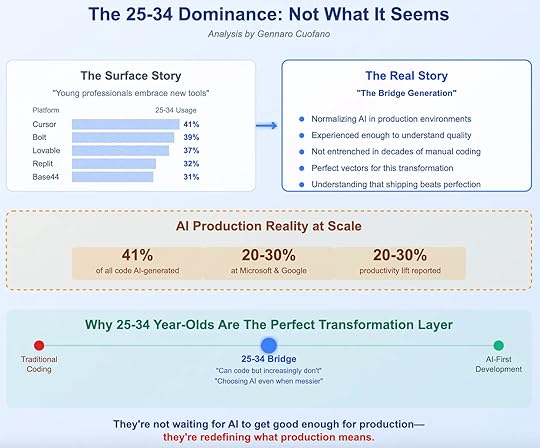The Bridge Generation for Vibe Coding

When analysts look at usage data for AI developer tools, they see a striking pattern: the 25-34 cohort dominates adoption. Cursor (41%), Bolt (39%), Lovable (37%), Replit (32%), and Base44 (31%) all report their heaviest engagement in this demographic band. The surface interpretation seems obvious: young professionals embrace new tools faster. But this view misses the deeper structural truth.
The real story is not about youthful enthusiasm. It is about generational positioning. The 25-34 demographic is not simply “adopting” AI—they are the bridge generation actively redefining what production means.
The Surface Story: Young Professionals Embrace New ToolsOn the face of it, the data looks like another case study in early adoption. This group grew up with rapid technological change. They are digitally fluent, willing to try unproven platforms, and less burdened by habits formed in the pre-AI era.
Their heavy usage of tools like Cursor or Bolt might suggest a familiar innovation diffusion curve: innovators and early adopters leading the way, older cohorts lagging behind. But this interpretation risks trivializing the transformation.
The surface story says adoption is about novelty. The deeper reality is that adoption is about structural necessity.
The Real Story: The Bridge GenerationThe 25-34 group is uniquely suited to normalize AI in production environments for five reasons:
They are experienced enough to understand quality. Unlike students just entering the workforce, they know what production code should look like, what breaks in deployment, and what matters in shipping.They are not entrenched in decades of manual coding. Older engineers may carry strong biases from long careers of handcrafted systems. The bridge generation has less to unlearn, making them flexible.They are perfect vectors for transformation. They hold roles that carry both execution responsibility and growing influence. They are close enough to the code to adopt tools, but senior enough to shape team norms.They know that shipping beats perfection. Having grown up in the startup and agile era, they instinctively prioritize velocity. Perfection is a liability when markets reward iteration.They embrace messiness. AI-generated code is imperfect, but this cohort understands that imperfect tools can still deliver production value at scale.This is why 25-34 is not just a demographic sweet spot. It is a structural hinge. They are the only group both trusted with production and unencumbered by the dogmas of the past.
AI Production Reality at ScaleWhat once looked like experiments is now operating at global scale:
41% of all code is AI-generated. This is not a fringe statistic—it represents a baseline shift.At Microsoft and Google, teams report a 20-30% productivity lift from AI integration.Across industries, similar productivity uplifts are being measured, even with quality caveats.This proves that AI in production is not a trial balloon. It is a present reality. The bridge generation is not waiting for tools to mature; they are actively bending production practices around AI’s current capabilities.
Why 25-34 Year-Olds Are the Perfect Transformation LayerImagine coding as a timeline:
On one end sits traditional coding—manual, line-by-line, perfectionist.On the other end lies AI-first development, where humans orchestrate and supervise but rarely write raw code.In between sits the 25-34 bridge.They can code, but increasingly they choose not to. They select AI even when it produces messy outputs, because they know iteration beats polish. They understand the trade-off: elegance sacrificed for speed. But they also understand the gain: competitive advantage in time-to-market.
This is why they form the transformation layer. They are not simply using new tools; they are actively redrawing the boundary between coding and production.
The Deeper Shift: Redefining ProductionThe most important insight is captured in the closing line of the analysis:
“They’re not waiting for AI to get good enough for production—they’re redefining what production means.”
This is not semantics. Traditionally, production implied rigor, stability, and quality assurance. But in the hands of the bridge generation, production is being re-anchored around velocity, iteration, and resilience through constant shipping.
In this redefinition:
Production code does not need to be perfect, only deployable.Quality is no longer a static benchmark; it is something that emerges from rapid cycles of use and repair.The measure of success is not elegance but adaptability.By this standard, AI is already “good enough”—because the meaning of “good enough” has changed.
The ImplicationsFor organizations: Enterprises that wait for AI to reach old benchmarks of quality will lose to those that embrace new definitions of production. The bridge generation is already rewriting these norms internally.For education: Teaching young developers to write flawless code may be less valuable than teaching them how to evaluate, direct, and repair AI-generated outputs.For markets: Valuations of AI coding platforms like Cursor or Lovable are justified not just by hype but by structural inevitability. Demand will not retreat; it will compound as norms shift.For strategy: The decisive battleground is not between AI and humans but between different definitions of production. The winner is whichever cohort convinces organizations to adopt its standards.Conclusion: The Bridge as DestinyThe dominance of the 25-34 cohort is not a coincidence of youth or enthusiasm. It is the product of structural alignment: old enough to be trusted, young enough to change.
They are the bridge between traditional coding and AI-first development, between the era of perfection and the era of speed. Their dominance signals not just adoption curves but the redefinition of software itself.
The surface story tells us they are embracing new tools. The real story is far more consequential: they are rewriting what production means.

The post The Bridge Generation for Vibe Coding appeared first on FourWeekMBA.



